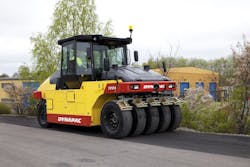Once used primarily as an “in-between” roller ceding final compaction glory to its vibratory drum siblings, the pneumatic-tire roller is carving out additional niches by rolling various materials.
Manufacturers are reacting by updating their on-board technology and offering more options along with the required Tier 4-Interim updates.
Pneumatic-tire units are often used on “scratch courses,” which are very thin lifts of hot mix asphalt to fill depressions and level up the surface prior to resurfacing. “They’re also excellent machines to seat stone or gravel when spraying seal coats on farm-to-market roads or on shoulder rehabilitation,” says Mike Watt, product manager for Volvo Construction Equipment.
More finish rolling
Watt also maintains that the pneumatic-tire roller can be used as a final roller on hot mix to tighten or seal the surface.
Cost of Ownership
Size Class Average Price Hourly Rate* To 2.4 metric tons $61,099 $42.48 2.5-3.4 metric tons $130,106 $64.91
3.5 metric tons and up $130,378 $65.77
*Hourly rate represents the monthly ownership costs divided by 176, plus operating cost. Unit prices used in this calculation: Diesel fuel, $3.98/gallon; mechanic's wage: $51.24/hour; money costs, 1.75%. Source: EquipmentWatch.com.
Bomag’s Chris Connolly, manager, Key Accounts, is another expert who touts the pneumatic-tire roller’s ability to be a finish roller.
“Rolling with pneumatic compactors can increase pavement’s density over that achieved by steel wheel or vibratory compactors when temperatures are above 175 F,” Connolly says. “It produces a closer textured pavement surface, as well, which exhibits decreased permeability. Pavement distortion under heavy traffic loads is also lessened, due to the increased stability produced.”
“Other applications beside rolling surface treatments like chip and seal include soil stabilization with modifiers such as asphalt emulsion, calcium chloride, fly ash, lime, Portland cement, or other materials,” adds Watt.
Dynapac product marketing manager Vijayakumar Palanisamy says he’s seen a recent trend toward using pneumatic-tire rollers on soil for proof rolling. “Contractors in Texas find this method is a very useful technique to check the soil stability,” he says. “They roll fully ballasted 50,000 pounds of pneumatic roller back and forth for the entire job site to ensure compacted soil doesn’t sink under heavy loads.”
Palanisamy also cites cold in-place asphalt paving as a growing application for pneumatic-tire rollers.
“Traditionally, pneumatic-tire rollers have been used as an intermediate roller behind the breakdown rollers in asphalt paving,” he says. “With cold in-place asphalt paving getting popular, concerns of over compacting and breaking of the cold material with traditional double-drum vibratory rollers make pneumatic-tire rollers an ideal choice to use behind the paver to achieve the required compaction effort.
“These pneumatic-tire units are adequately ballasted to provide required static weight and the kneading effort to achieve the required density,” Palanisamy says.
Not just operating weight
Connolly tells equipment managers it’s less about weight than about wheel load and tire inflation pressure. “Some contracting agencies specify the total weight of the pneumatic roller to be used; however, this has little or no effect on any roller’s ability to compact,” he says. “Evaluations of individual wheel loading, gross vehicle weight, or weight per linear dimension of rolling width alone are not sufficient to accurately evaluate the compaction capability of any pneumatic-tire roller.”
Tire pressure is crucial to roller performance.
“Increasing the total gross weight carried by an individual tire without changing the tire inflation pressure only increases tire contact area,” Connolly says. “The net result is only a marginal increase in unit contact pressure—inflation pressure has a greater effect on contact pressure than on individual wheel load. When tires are inflated to higher pressures, their ground contact area actually becomes smaller, resulting in a higher unit pressure. This pressure increase helps increase manipulation and compaction of the hot-mix asphalt.”
The kneading action of the rubber tires achieves manipulation and compaction, as well as high ground contact pressure. (See the chart below for contact pressure values at varying tire inflation pressures, using a popular size of pneumatic roller tire as an example.)
New developments in rollers
As with most other equipment categories, manufacturers are changing and updating engines to meet T4-I emissions requirements. Some are taking the opportunity to do more.
“In the process of upgrading the power pack, they are also focusing on improving operator comfort by modernizing controls, reducing noise levels, and providing better ROPS/FOPS structures,” says Dynapac’s Palanisamy. Dynapac’s nine-tire CP274 went to T4-I and also gained improvements in serviceability, as well as enlarged capacity in its cooling system.
Caterpillar has not only upgraded the engine on its CW34, but has also added a number of new or enhanced features, such as flexible ballast options, an eco-mode that reduces fuel consumption and noise levels, a new operator’s console with LCD monitor, and an optional air-on-the-run feature that allows the operator to adjust tire pressure during operation. Another option is Cat Compaction Control, which provides temperature and pass-count mapping.
Hamm has upgraded its GRW280i series with T4-I emissions technology and subtle design changes like a revised ballast compartment that allows users to vary the operating weight more easily and flexibly than before, according to the company.
Managers will continue to see more of these high technology features incorporated into rollers in the future as standard equipment, and not necessarily as options. “Manufacturers may also offer intelligent compaction technology, without an accelerometer, similar to soil and double-drum asphalt rollers,” Palanisamy says. “This technology helps to keep the pass count and also map the temperature of the asphalt material being compacted. DOTs started to mandate intelligent compaction with soil and double-drum rollers, in the future that might be the case with pneumatic-tire rollers as well.”





